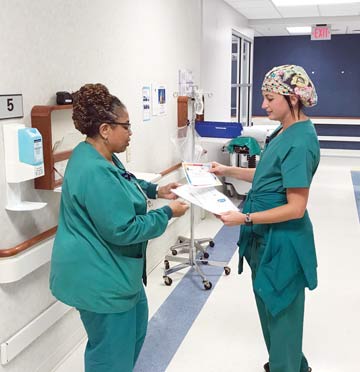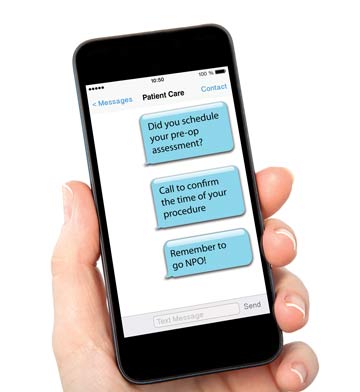Patient-centered care is one of surgery's hottest buzzwords for a reason. The patients who walk into your facility expect excellent surgical care. That much is a given. It's the efforts you make to improve communications, lessen their anxiety and tap into technology to educate and inform that will overdeliver on their already high expectations and set your facility apart in increasing competitive healthcare markets.
- Home
- Article
3 Ideas to Improve Patient Satisfaction
By: Adam Taylor
Published: 10/14/2019
Think outside the box to communicate with and calm your most important customers.
1. Individualized attention
Patients remember everything that happens before surgery. That's when they were hypervigilant, hyperaware, anxious, and very interested in what is going on. A patient's overall experience is very much impacted by what happens prior to them going into the OR, and that's reflected in their survey responses.
Staff at Bon Secours Surgery Center at Harbour View in Suffolk, Va., use purposeful rounding with the patients and their families to prevent an issue from happening, or to address it in real time if it does. Keeping patients and their family members informed — and providing immediate answers to unforeseen issues — gives them the comfort they need at a stressful time. "Make sure members of the clinical team, business staff and leadership take part," says Patrick Guzik, administrator at Bon Secours. "Even if there's no issue, introduce yourselves, talk about things such as the expected length of the stay and explain what's happening now and what will be happening soon."
Patients often ask staff at Bon Secours, "Why was I told to be here at 9 a.m. when it's 11:30 a.m. and I still haven't gone into surgery?" This issue is a challenge for many facilities, because the scheduling and registration process is not completely under their control. Some physician's offices schedule patients to arrive well before they really need to. Doctors want to stay busy, so they want to be able to squeeze in the early arriver if another case gets canceled. While that may be more efficient for the surgeon, it causes unnecessary anxiety for the patients and their family members. To minimize this issue, suggests Mr. Guzik, coordinate closely with physician's offices to make sure patients arrive at an appropriate time for their procedures. Patients, however, don't make distinctions about who's to blame for their long waits.
"We were able to engage the physicians and that paved the way for us to share our center's schedule with their offices, which allowed us to establish more appropriate times for patients to show up before their procedures," says Mr. Guzik.
Bon Secours also uses Care Cards, which are simply 5-by-7 index cards, to keep staff informed about a patient's specific clinical needs or concerns. Staff note patients' issues or concerns on the cards, which stay with the patients' cards from pre-op to PACU. If, for example, a patient had a bad IV stick during a previous surgery or got sick at home after general anesthesia, they shouldn't have to voice those concerns to staff during every handoff between providers. Those issues are noted on the card, and each staff member who gets handed a chart should mention the specific concern to the patient, so patients know staff is aware of it.
2. Music therapy

In addition to standard calming techniques, more facilities are using music and aromatherapy to help ease patients' pre-op anxiety. In fact, a recent study showed patients who listened to music through headphones minutes before receiving a peripheral nerve block experienced similar decreases in anxiety levels as patients who were administered 1mg to 2mg of midazolam before the block was placed (osmag.net/8XCAyt).
"The study is proof that there are drug-free alternatives to help calm a patient before certain procedures," says study co-author Veena Graff, MD, an assistant professor or anesthesia and critical care medicine at Penn Medicine in Philadelphia, Pa. "Based on our findings, we now provide our ambulatory surgical center patients who want to listen to music with access to disposable headphones. Ultimately, our goal is to offer music as an alternative to help patients relax during their perioperative period.
Although previous studies have shown music's calming effect on patients before surgery have compared music to oral sedatives, which aren't often used in pre-operative settings, the Penn Medicine study was the first to compare music with an IV form of a sedative medication.
In general, says Dr. Graff, music lightens up the emotional ?and pleasure centers in brains. It also sends out projections to the hypothalamus, where it affects heart rate, blood pressure and breathing. This explains why some songs trigger a variety of emotions — good feelings, bad feelings, nostalgia, happiness, sadness. "A greater understanding of what music does to our bodies can help relax patients in the moments before they undergo a bedside procedure such as nerve bock or before they're wheeled back for the surgery," she says.
Dr. Graff believes the benefits of music are underutilized in healthcare settings, especially now that patients have near limitless access to catalogues of songs on media players and smartphones. She encourages you to offer disposable headphones to patients in pre-op and invest in media players or music apps on media devices, so patients can listen to music in the stressful time before surgery (see Help Patients Tune in to Tune Out").
3. Hi-tech engagement

A website geared for patients who are scheduled for surgery is about to launch at Baptist Hospital in Miami, Fla. The site will include written explanations, downloadable PDFs, photos, diagrams and eventually videos on everything from where to park to specific pre-op bathing instructions.
Topics covered on the site will include what items patients should bring on the day of surgery, information about how they can help prevent surgical site infections, the basics of pre- and post-op care, a list of hospital phone numbers they'll need, answers to frequently asked questions and presentations on what their overall experience is going to look, feel and sound like.
"Some patients are thirsty for as much information as possible and this site is designed with them in mind," says Rachel Evers, MSN, RN, CNOR, the hospital's director of surgical services. "The information is there so they can access it on their own time before surgery. We'll provide the information in a variety of ways so we're sure it will be there in the form a patient prefers to receive it."
The ASC at Westmed Medical Group, a multi-specialty practice in New York and Connecticut, has an online portal and a mobile app, which patients use to receive pre-op and post-op instructions. The technology helps patients become more actively involved in their own care by doing such things as sending messages to their providers, managing their prescriptions and accessing lab results.
Surgeons like the communication app, too. If they want to change a patient's medication, they can make the change, contact the pharmacy and inform the patient — all without having to make a phone call. Westmed Medical has a roadmap in place to implement more patient engagement software in the future, such as apps that will let a staff member in the operating room text a patient's loved ones with updates during surgery. "Expanding our reach gives patients options on how to get the care they need and take control of their own health care," says Lisa Sershen, chief digital officer at Westmed Medical. "But while these digital tools allow us to text and chat with patients and loved ones, we'll never step away from the human touch."
At Bon Secours Surgery Center, though, half of the patients are older and getting cataract procedures, so it's worth having a nurse to make follow-up phone calls. It's during those phone calls that patients let staff know that they're feeling great, that their pain is under control and they're not nauseous. Patients also sometimes share their frustrations with how long they had to wait before their procedures started. "When that happens, we can explain the process and how their situation led to a wait that was longer than needed," says Mr. Guzik. "A patient who understands what happened and has the chance to talk with someone about it is likely to be less critical on a satisfaction survey." OSM
.svg?sfvrsn=be606e78_3)
.svg?sfvrsn=56b2f850_5)